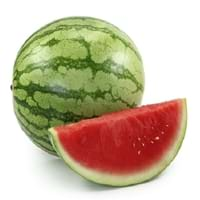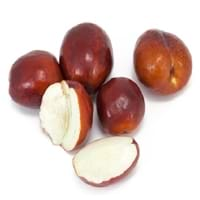Health Benefits
Anti-aging benefits, Anti-inflammatory properties, Asthma treatment, Body hydration, Cancer prevention, Digestive aid, Skin cleansing, Skin rejuvenation
Cancer prevention, Diarrhea treatment, Improves muscular strength, Liver health, Maintains hormonal balance, Reduces nervous tension, Reduces blood circulation problems, Reduces stress, Regulation of heart rate, Treatment of hysteria
General Benefits
Anti-inflammatory properties, Body hydration, Controls blood pressure, Digestive aid, Maintains healthy cholesterol level
Anti oxidant properties, Digestive aid, Flu treatment, Helps in weight loss, Strengthens bones, Treatment of common cold
Skin Benefits
Anti-aging benefits, Brightens and lightens complexion, Hydrates skin
Heals sunburn, Hydrates skin, Reduces wrinkles, Skin rejuvenation, Skin revitalization
Hair Benefits
Promotes longer and healthier hair, Regulates hair growth
Promotes longer and healthier hair, Protects hair
Allergy Symptoms
Breathing difficulty, Decrease in blood pressure, Dizziness, Eczema, Hives, Runny nose, Swelling of mouth, tongue or lips, Watery eyes
Abdominal pains, Breathing difficulty, Diarrhea, Hives, Itching in eyes, Itching of nose, Nasal congestion, Redness of eyes, Runny nose, Sneezing, Wheezing
Side Effects
Allergic reaction, Bloating, Diarrhoea, Indigestion, Intestinal gas, Nausea, Vomiting
Decrease in blood sugar levels, Intense headache
Lactating Women
Yes
Not Available
Best Time to Eat
As a snack in the late afternoon, Don't consume at night and before bed, Eat the fresh ones, avoid mixing with any other foods, don't eat after meal., Strictly avoid empty stomach
As a snack in the late afternoon, Don't consume at night and before bed, Morning time (before lunch), Strictly avoid empty stomach
Vitamin B5 (Pantothenic Acid)
Not Available
Vitamin B9 (Folic acid)
Not Available
Vitamin C (Ascorbic Acid)
Vitamin E (Tocopherole)
Not Available
Vitamin K (Phyllochinone)
Not Available
Lutein+Zeaxanthin
Not Available
Phytosterol
Not Available
Calories in Fresh Fruit with Peel
Not Available
Calories in Fresh Fruit without Peel
Not Available
Calories in Frozen Form
Not Available
Not Available
Calories in Canned Form
Not Available
Not Available
Calories in Juice
Not Available
Calories in Jam
Not Available
Calories in Pie
Not Available
Type
Berry, Melon
Tree fruit
Season
Summer
Autumn, Summer
Varieties
Sugar Baby, Sangria, Golden Midget, Starlight, Jubilee, Starbrite, Extazy, Stars 'n' Stripes, Mickylee, Yellow Baby, Yellow Doll, Little Baby Flower, Sweet Favorite and Cream of Saskatchewan
Honey Jar, Sugar Cane, Li, Shanxi Li, Sherwood, Chico, Silverhill, Tigertooth, Winter Delight and Lang
Color
Canary yellow, Coral red, Orange, Salmon yellow, Scarlet red, White
Green, Red, Yellow
Origin
Southern Africa
Syria
Soil Type
Sandy, Well-drained
Sandy, Well-drained
Climatic Conditions
Dry, Hot
Warm to hot climate
Facts about
- Watermelon contain 91% of water.
- In Japan & Chine, watermelon is a popular gift to bring a host.
- Entire watermelon is edible, even the rinds & seeds.
- There are more than 1200 varieties grown in the world.
- Pigment extracted from Indian jujube is used for silk dyeing in Burma.
- In Korea, jujube wood is used to make wind instrument taepyeongso.
- Fresh jujube is known as Chinese apple & dried form is called as Chinese date.
Other Countries
Algeria, Brazil, Egypt, Iran, Kazakhstan, Mexico, Spain, Turkey, United States of America
Bangladesh, India, Iran, Korea, Lebanon, Pakistan
Top Importer
Germany
United States of America
Botanical Name
Citrullus Lanatus
Ziziphus zizyphus
Synonym
Citrullus vulgaris
Ziziphus jujuba or Ziziphus mauritania or Zizyphus jujuba
Subkingdom
Tracheobionta
Tracheobionta
Division
Magnoliophyta
Magnoliophyta
Class
Magnoliopsida
Magnoliopsida
Subclass
Dillenhidae
Rosidae
Order
Cucurbitales
Rosales
Family
Cucurbitaceae
Rhamnaceae
Species
C. lanatus
Z. zizyphus
Generic Group
Gourd
Not Available
Difference Between Watermelon and Jujube
We might think that Watermelon and Jujube are similar with respect to nutritional value and health benefits. But the nutrient content of both fruits is different. Watermelon and Jujube Facts such as their taste, shape, color, and size are also distinct. The difference between Watermelon and Jujube is explained here.
The amount of calories in 100 gm of fresh Watermelon and Jujube with peel is Not Available and 79.00 kcal and the amount of calories without peel is 30.00 kcal and Not Available respectively. Thus, Watermelon and Jujube belong to and category.These fruits might or might not differ with respect to their scientific classification. The order of Watermelon and Jujube is Cucurbitales and Rosales respectively. Watermelon belongs to Cucurbitaceae family and Jujube belongs to Rhamnaceae family. Watermelon belongs to Citrullus genus of C. lanatus species and Jujube belongs to Ziziphus genus of Z. zizyphus species. Beings plants, both fruits belong to Plantae Kingdom.









